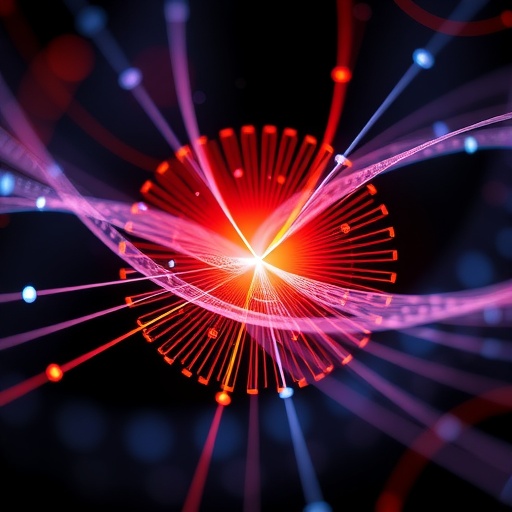In a remarkable leap forward for the field of spintronics, researchers from Korea University and Seoul National University have unveiled a pioneering approach to controlling electron spin using chiral ferromagnetic nanohelices. This innovative technology harnesses the subtle interplay of structural geometry and intrinsic magnetism within nanoscale materials, enabling efficient spin-selective transport at room temperature. The findings, recently published in Science, open new horizons for next-generation information storage and spin-based electronic devices, circumventing longstanding challenges related to material synthesis and spin manipulation.
Spintronics relies fundamentally on the intrinsic angular momentum—or spin—of electrons, promising a paradigm shift in computing and data storage technologies by transcending the limitations imposed by conventional charge-based electronics. Central to advancing this field is the development of materials that can robustly and selectively filter electron spins. The Korea-Seoul research team has addressed this by engineering chiral magnetic nanohelices whose handedness can be precisely programmed, thereby controlling the directional flow of electron spins with unprecedented efficiency.
The crux of this breakthrough lies in the successful fabrication of three-dimensional inorganic nanohelices exhibiting well-defined chirality—right- or left-handed twists—through an electrochemical growth process meticulously guided by trace amounts of chiral organic molecules. This subtle addition acts as a molecular director during metal ion reduction, steering the crystallization to form helices with the desired helicity. The ability to dictate handedness at such a fine scale in inorganic materials is an extraordinary feat given the synthesis challenges traditionally associated with chirality control in metal nanostructures.
Experimental characterization confirmed that these chiral nanohelices achieve spin polarization levels exceeding 80%, a metric reflecting the degree to which electron spin orientation can be sorted or filtered by the material. Crucially, this high spin selectivity is achieved solely through the intertwined effects of the nanohelices’ geometry and ferromagnetism, without relying on complex magnetic circuits or cryogenic environments. This represents a significant practical advance, as it allows spin-based effects to manifest at ambient temperatures with scalable fabrication methods.
Professor Young Keun Kim from Korea University, co-corresponding author of the study, emphasized the uniqueness of this approach: “Our method combines structural chirality and intrinsic ferromagnetism in a way that enables efficient spin filtering simply through nanohelix design. This geometric and magnetic synergy provides a new framework for engineering electron spin behavior without the typical technological overhead.”
Underlying the spin transport phenomenon is the concept of magnetization within the nanohelices. The inherent ferromagnetic ordering aligns electron spins over considerable distances, maintained by strong exchange energy interactions. This magnetization facilitates long-range spin coherence that remains stable regardless of the orientation between the chiral axis of the helix and the spin injection direction, a behavior absent in analogous non-magnetic nanoscale helices. This observation marks the first empirical demonstration of asymmetric spin transport in relatively large-scale chiral inorganic structures.
To rigorously verify the chirality of the nanohelices, the team developed an innovative electromotive force (emf)-based measurement technique. By subjecting the helices to rotating magnetic fields, the researchers detected opposite emf signals corresponding to left- and right-handed helices. This allowed them to quantify chirality even in materials with weak light-matter interaction, overcoming a persistent hurdle in nanoscale chirality evaluation. Such a methodology provides a powerful tool for future studies targeting chiral inorganic nanomaterials.
The technological implications of this research extend beyond fundamental science. The researchers demonstrated a prototype solid-state device based on their chiral nanohelices, successfully exhibiting spin-dependent conduction signals. This proof of concept illustrates the potential for integrating these materials into practical spintronic elements that leverage chirality to control spin currents without external magnetic fields or cryogenic cooling, thereby streamlining device architectures.
Professor Ki Tae Nam of Seoul National University, also a co-corresponding author, highlighted the broader significance of the work: “Chirality is a foundational principle in organic chemistry and biology, often dictating molecular function. Our success in programming inorganic chiral structures at the nanoscale represents a materials chemistry breakthrough that could transform spintronic device engineering.”
Besides enabling directional spin transport, the technique affords versatile control over nanostructure morphology. By adjusting the electrochemical conditions and chiral molecule concentrations, researchers can modulate not only the helicity but also the number of strands in the nanohelices, enabling access to double or multiple helical configurations. This tunability unlocks a rich design space where geometric and magnetic parameters can be jointly optimized for targeted spintronic functionalities.
Looking forward, this research sets a foundational platform for the emerging field of chiral spintronics. The convergence of geometry, magnetism, and electron transport within scalable inorganic nanoarchitectures promises a pathway to robust, energy-efficient spin devices suitable for integration into existing semiconductor technologies. The work points toward new possibilities in data storage, logic operations, and quantum information processing where spin-selective control is paramount.
In summary, the Korea University and Seoul National University collaboration has charted a new direction in nanoscale magnetism and spin transport by delivering chiral ferromagnetic nanohelices capable of spin polarization surpassing 80% under ambient conditions. Their elegant electrochemical synthesis guided by chiral molecules circumvents prior limitations in inorganic chirality control, enabling practical exploitation of geometric and magnetic effects to manipulate electron spin. This breakthrough paves the way for scalable, room-temperature spintronic devices that harness structural design principles to channel electron behavior in fundamentally novel ways.
Subject of Research: Spin-selective electron transport through chiral ferromagnetic nanohelices
Article Title: Spin-selective transport through chiral ferromagnetic nanohelices
News Publication Date: 4-Sep-2025
Web References:
10.1126/science.adx5963
Image Credits: Korea University and Seoul National University
Keywords
Spintronics, chirality, ferromagnetism, nanohelices, spin polarization, electron spin control, chiral magnetic materials, electrochemical synthesis, spin filtering, nanoscale magnetism, spin transport, room-temperature spintronics




